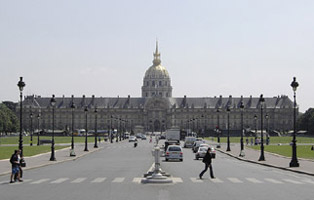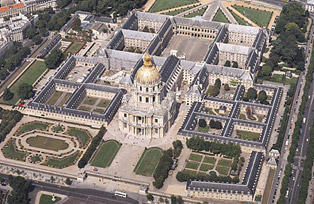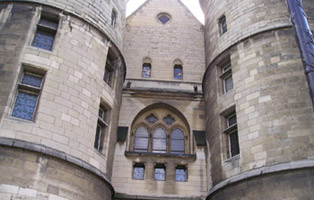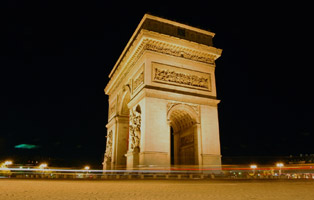ATTRACTIONS OF PARIS
L'HOTEL DES INVALIDES
Avenue de Tourville (7è)
M° Invalides - La Tour Maubourg
L.8/13
RER C Invalides
Tel: 01 44 42 37 67
Opening: 10.00 -18.00 every day (payment on admission)
The institution of the Invalides dates from Louis XIV, and was created for the purpose of helping old and maimed soldiers, who were otherwise reduced to seeking care in convents or to begging. The institution was founded in 1670 and very quickly received a large number of injured soldiers. The plans were drawn up by Libéral Bruant, but construction wasn’t completed until 1676.
HISTORIAL CHARLES DE GAULLE
An exceptionnal audiovisual show at the "Musée de l'Armée" at the Invalides.
Open everyday from 10am till 6pm
M° Invalides - La Tour Maubourg
L.8/13
RER C Invalides
www.invalides.org
The dome that sits atop the central church is
the work of Jules Hardouin Mansart and satisfied perfectly the
wish of Louis XIV that it should reflect the glory of his reign.
The church of St Louis des Invalides, situated inside the dome,
is also the work of Mansart and within it hang flags captured
from the enemy, serving to decorate the interior.
1 quai de l'Horloge (1er) - M° Cité
Tel: 01 53 40 60 80
Opening hours:
April – September: 9.30 – 18.00 every day
The Concierge of the Palace was once an important position; the person who received charges on the rental of the stores that belonged to the palace. The Conciergerie was later transformed into a prison; the accused were detained therein until they were judged. Some famous people were held in the cells of the Conciergerie, which could hold over 1,000 prisoners at a time.
The building became morbidly famous during the revolution, as it was there that Marie Antoinette was held captive until being sent to the guillotine. Her cell has been reconstructed and can now be visited. During the Reign of Terror, the Conciergerie served as the antechamber of the Revolutionary Tribunal. Here, the Girondins were locked up by Danton – who later would be imprisoned there himself. Next it was the turn of Robespierre to be held within its walls, having been condemned by Thermidor. On the exterior of the building can be seen the clock tower that displayed the first public clock in Paris, this was resored in the 19th century.
L'ARC DE TRIOMPHE
M° Charles de Gaulle-Etoile
Tel: 01 43 80 31 31
Opening: 10.00 -18.00 every day
The origin of the Arc de Triomphe (situated at the top of the Champs-Elysées) reaches back to 1806 when Napoleon conferred upon Chalgrin the task of erecting an arch to the glory of the French army. Building began in 1806 and was taken up again in 1825, to be completed in 1836. The Arc de Triomphe is based on other similar arches from antiquity, but differs from them because of its monumental size; 50m tall and 45m broad. The upper part of the monument bears magnificent high reliefs of which the masterpiece is Rude’s “The Departure of the Volunteers of 1792”.
On the 15th December 1840, a ceremonial cortege passed under the arch bearing the ashes of Napoleon. On the 22 May 1885 a guard of honour kept the body of Victor Hugo under the arch all through the night, before his interment in the pantheon. On the 14 July 1919, the victorious troops marched under the arch and on the 11th November 1920, an unknown soldier who had died during the war was inhumed there. Three years later an ever-burning flame of memorial was lit to honour those who had fallen in war.
THE GEORGES POMPIDOU CENTRE

© Pariserve.com
Métro : Châtelet - Les
Halles, Les Halles, Rambuteau
Tél : 01 44 78 12 33
It was in 1969 that Georges Pompidou, who was
passionate about modern art, had the idea of creating an immense
modern cultural space right in the centre of Paris – at
Beaubourg, just a few hundred metres from Les Halles. He opened
a competition to design the centre
that would bear his name.
An international jury was set up towards the
end of 1970. They examined more than 650 designs, but in 1971,
it was the plan of Renzo Piano and Richard Rogers that emerged
the winner. Their design took the form of a enormous parallelepiped,
166 metres long, 60 metres wide and 42 metres tall. Innovative
in its design, the exterior of the structure would be adorned
with ocean liner chimneys and metal tubes, all painted bright
colours.
The local residents and passers by were mystified. The press leapt
on the subject and stoked the polemic that was already developing.
When the centre finally opened its doors, on 31st December 1977,
several visitors were astonished by the presence of scaffolding
on the outside of the building. The architectural event provoked
excited reactions all across the world. Many cried out against
the presence, in the heart of Paris, of this “pile of tubes,
plastic, timber and glass”.
The architects had certainly created a rich space on the interior. Each level of the building has on open space of 7,500 square metres. This was made possible because all of the elevators, escalators and all of the ventilation and electricity pipes had been pushed outside to the façade of the building.
The colour of each girdle and plinth corresponds to its function: blue for air conditioning, green for liquids, red for transportation and yellow for electricity. Facing the piazza, a great mechanical escalator reaches diagonally across the front of the building, encased in a glass tube and held in place by coloured hoops.
Renovation works had to be undertaken on the Centre Beaubourg in 1997, to repair damage that had been done by the weather and to renew the buildings facilities, worn down by a far greater number of visitors that had initially been foreseen. The building was closed during this time and reopened its doors towards the end of 2000.
For more information : category "Monuments/Buildings".
Of course, Paris has many more monuments to offer, such as the Palaces or Icons of Paris. Enjoy your visit!
- Paris-city Partners :
- Music News
- Rock, Jazz & Blues CDs
- Learn French in Paris
- Learn French in France
- Paris Junior Programs
- Learn English in England
- Business English Courses
- Need a translation?
- For teachers of French
- French Exercise & Tests
- Directories
- English courses for Teens in UK
- Camps for Teens in England
- Language Courses Abroad
- English courses in England
- Learn a Language Abroad






